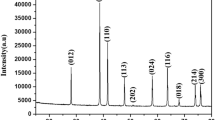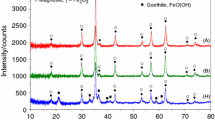Results of a study of nitriding of iron with the use of boron, aluminum and silicon nitrides are presented. It is shown that the method suggested, which involves mixing of Fe powders with BN, AlN and Si3 N4, pressing of the briquette, heating in a nitrogen atmosphere to 1550°C, 3-h holding, and cooling with the furnace, gives specimens consisting of two parts, i.e., ceramic and metallic ones. The structure of the metallic part is represented by primary precipitates of iron and eutectic colonies of type Fe – Fe2 B in which a part of boron is substituted with nitrogen. The metallic specimens possess enhanced hardness and relatively high coercivity comparable to that of nitrided thin films and nanosize powders.



Similar content being viewed by others

References
J. P. Wang, Y. Jiang, Md. A. Mehedi, and J. M. Liu, “Bulk Fe16N2 compound permanent magnet with 20 MGOe magnetic energy product and beyond magnet,” in: Rare-Earth and Future Permanent Magnets and Their Application, pp. 234 – 240.
S. Kikkawa, K. Kubota, and T. Takeda, “Particle size dependence in low temperature nitridation reaction for Fe16N2,” J. Alloys Compd., 449(1 – 2), 7 – 10 (2008).
T. Ogi, Q. Li, and S. Horie, “High purity core-shell α″-Fe16N2 /Al2O3 nanoparticles synthesized from α-hematite for rare-earth-free magnet applications,” Adv. Power Technol., 27(6), 2520 – 2525 (2016).
R. Zulhujiah, K. Yoshimi, A. B. D. Nandiyanto, et al., “Advanced power technology α″-Fe16N2 phase formation of plasma-synthesized core-shell nanoparticles under various conditions,” Adv. Power Technol., 25(2), 582 – 590 (2014).
L. A. Chebotkevich, Yu. D. Vorob’ev, and I. V. Pisarenko, “Magnetic properties of iron nitride films obtained by reactive magnetron sputtering,” Fiz. Tverd. Tela, 40(4), 706 – 707 (1998).
I. M. Shatokhin, A. E. Bukreev, M. Kh. Ziatdinov, and B. A. Nikiforov, A Method for Alloying Steels with Nitrogen, Patent 2394107 RF, MPK C21C 7_00 [in Russian], appl. 13.04.2009, publ. 20.02.2010.
I. L. Knunyants (ed.), Chemical Encyclopedia [in Russian], Sovetskaya Entsiklopediya, Moscow, Vol. 2, 671 p. (1990); Vol. 3, 639 p. (1992).
E. V. Shelekhov and T. A. Sviridova, “Programs for x-ray analysis of polycrystals,” Metalloved. Term. Obrab. Met., No. 8, 16 – 19 (2000).
Software FACT-Win/F*A*C*T and ChemSage, http://www.crct.polymtl.ca/fact/documentation.
Th. De Donder and P. Van Rysselberghe, Thermodynamic Theory of Affinity. A Book of Principles [Russian translation], Metallurgiya, Moscow (1984), 134 p.
I. Prigogine and R. Defay, Chemical Thermodynamics [in Russian], Nauka, Novosibirsk (1966), 503 p.
Yu. N. Taran and V. I. Mazur, Structure of Eutectic Alloys [in Russian], Metallurgiya, Moscow (1978), 312 p.
Author information
Authors and Affiliations
Corresponding author
Additional information
Translated from Metallovedenie i Termicheskaya Obrabotka Metallov, No. 8, pp. 52 – 56, August, 2018.
Rights and permissions
About this article
Cite this article
Minkova, I.O., Menushenkov, V.P., Savchenko, E.S. et al. Effect of Bulk Nitriding on Magnetic Properties of Iron. Met Sci Heat Treat 60, 539–543 (2018). https://doi.org/10.1007/s11041-018-0315-1
Published:
Issue Date:
DOI: https://doi.org/10.1007/s11041-018-0315-1



